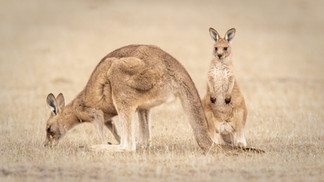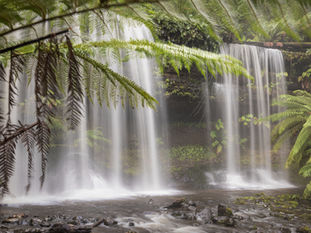
Maria Island is a picturesque gem where history and nature intertwines. From sweeping landscapes and geological wonders to historic ruins and an abundance of wildlife and birds... an endless array of photographic opportunities await!
When I think of Maria Island, the first thought that comes to mind is… wombats! OK, so this might have something to do with how obsessed I am with these charismatically endearing creatures! Anyone who knows me well - or has accompanied me on one or more of my many wombat-spotting adventures - would easily affirm my statement. I share more of my 'Wisdom of Wombats' story and photos on my online ' gallery at In Nature Photography.
Beyond the joy of spotting wombats roaming and grazing freely, Maria Island is a picturesque gem where nature, history and wildlife conservation come together in remarkable ways. Aside from the ferry to get there, there is no public transport on the island – just a few vehicles for park rangers and trade services. Once you’re on the island, you are treated to a peaceful escape allowing you to slow down and fully immerse in its distinctive beauty. Whether exploring on foot (or for some, by bicycle), you’ll be captivated by dramatic coastal landscapes, fascinating remnants of eras past and an abundance of wildlife and birds that will delight you at every turn.
With every step you take, this island tells a story. While wombats may steal the show, an endless array of photographic opportunities await your photographer’s eye. From sweeping landscapes to eucalypt forests and unique geological wonders on coastal cliffs - and of course all the other wildlife and birds too - Maria Island has a way of leaving a lasting impression. Let's explore more...
Introducing Maria Island – a little bit of history
Pronounced ‘Mar-eye-ah’, the island was named ‘Maria's Eylandt’ in 1642, by explorer and navigator Abel Tasman. In the same year, Tasman also named what is now known as Tasmania ‘Van Diemen’s Land’ in honour of Anthony van Diemen, Governor of the Dutch East India Company in Batavia (present-day Indonesia), and his wife Maria.
The Palawa (Tasmanian Aboriginal) name, as known by the Puthikwilayti people of the Oyster Bay Tribe, is Wukaluwikiwayna. For tens of thousands of years before Europeans arrived in Van Diemen's Land, the Puthikwilayti people made seasonal crossings to the island by canoe, particularly in winter when food sources on the main island of Lutruwita / Tasmania were less abundant.
Natural, Historic and World Heritage Values
Maria Island’s natural landscape is renowned for its dramatic seascapes, peaceful bays and pristine beaches, as well as its grassy plains and eucalyptus forests - all set against a backdrop of majestic mountains or open sea. Among its many hidden gems, the island’s iconic natural features are truly remarkable. Fossil Cliffs, for example, showcases fossilised remnants, that create a natural museum, embedded in the layers of geological time. Painted Cliffs, on the other hand, offers a breathtaking display of vivid colours, textures and patterns, transforming the cliff face into an artwork of Mother Nature.
The island is also home to a range of convict and historical structures from various eras, each offering a fascinating glimpse into its rich history. Darlington Probation Station stands as a key testament to the island’s convict past, predating the more well-known Port Arthur settlement. Meanwhile, other historical remnants highlight its industrial and agricultural periods that followed. In the 1960s, a fauna reserve was established and in 1971, Maria Island was declared a national park.
By blending the built features with the natural landscape, Maria Island creates a unique historical intrigue that adds depth and storytelling potential to your photography, making each shot even more special.
Abundant Wildlife and Birds
Maria Island is often referred to as a modern-day Noah’s Ark due to its protected habitat that serves as a haven for a wide variety of species. From kangaroos, wallabies and pademelons to bandicoots and echidnas, and of course, wombats, the island offers an ideal environment for endangered species to thrive. Even a population of Tasmanian Devils has been introduced to the island as part of a conservation effort, to ensure the survival of this iconic species in the wild.
The birdlife here is equally impressive. Maria Island is home to a diverse array of native species, including robins, cuckoos, honeyeaters, thornbills, native geese and hens. Majestic eagles and falcons often soar above, while along the coastline, waders and shorebirds can be spotted. Whether you join one of our guided tours or explore independently, you’re likely to encounter a fabulous diversity of bird species in a just a few hours.
You’ll want to take many moments to observe the numerous wombats and all the other wildlife you’re likely to encounter. It's important for us humans to maintain a respectful distance from the wildlife, however a wombat might approach you with curiosity, offering an enchanting and unforgettable up-close encounter.
From the moment you arrive on the island, until you depart, you’ll be captivated by the endearing nature and incredible variety of wildlife that calls this island home.
Getting to and exploring Maria Island
Maria Island lies just 4 kilometres (2.5 miles) off the east coast of mainland Tasmania. The island is about 20 kilometres (12 miles) long and 13 kilometres (8 miles) wide, spanning around 115 square kilometres (44.6 square miles).
The island is most easily accessed by passenger ferry from Triabunna and a 30-minute journey across the Mercury Channel to Darlington, on Maria Island. As we approach the island on the ferry, and before you even step onto the jetty, your senses will awaken to the natural beauty and history that Maria Island has to offer.
The ferry is operated by Encounter Maria, and it’s best to book tickets in advance. And remember, national park entry passes are required too. However, when you book a Shutterbug Walkabouts experience to Maria Island, we’ll handle all the details and guide you every step of the way.
Maria island is a national park with marine reserve skirting part of its coastline. With no motorised transport available, it’s the perfect place to explore on foot allowing you to meander leisurely and fully immerse yourself in the stunning surroundings. For those who prefer, bicycles are available to hire offering another way to get around. There is an airstrip on the island catering to those who wish to enhance their visit with arrival or departure by air and a cruise that takes you around the island too.
Stay longer, take more photos ;-) There are several options for how long you can spend on Maria Island, depending on the experience you’re looking for. A relaxing day trip allows you to explore the island’s highlights before returning to the Tassie mainland in the afternoon.
Staying overnight offers the chance to enjoy the company of wombats into the evening, or witness a little spar between wallabies or kangaroos and perhaps even spot a Tasmanian Devil after dark on a wildlife spotting walk. Twilight, sunset, sunrise and night sky photo shoots are also on offer. Imagine swirls of vibrant colour intesifying as the evening light illuminates the rock face at Painted Cliffs, revealing nature's masterpiece in all its splendour. Or the historic convict-built buildings bathed in the soft glow of twilight and their weathered stone walls telling tales of a bygone era adding a timeless charm to the scene.

Where will you stay? For a rustic experience, staying in the bunk-style accommodation in the historic Darlington Probation Station’s Penitentiary complex provides a unique glimpse into the island’s past. Just keep in mind that you’ll need to bring your own sleeping gear and supplies, as it’s completely self-catered. Alternatively, you can camp in the designated campground, but like the bunkhouse, this requires you to be fully self-sufficient. When you book a guided Shutterbug Walkabouts photography experience, we’ll help you prepare accordingly for your chosen option.
If you seek a little more comfort, keep an eye out for one of our specialty small group experiences with exclusive access to Bernacchi House, a heritage-listed residence not open to the general public. These experiences are only available on select occasions throughout the year and are fully inclusive experiences ensuring everything is taken care of for you.
Ready to capture the magic of Maria Island? Join us for an unforgettable photography experience, where nature, history and breathtaking landscapes await.
View more photos in our gallery








































